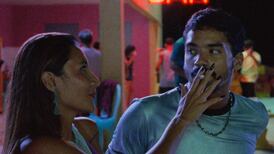VISUAL ARTS:SIMON ENGLISH'S paintings in Departures, his show at the Vangard Gallery, have a storybook quality. They draw us into a mysterious, half-lit world in which vast empty spaces impinge on isolated islands of habitation: a house in the woods, a ship on a foggy sea, a car making its tentative way across an empty landscape. We view these things from a distance, and the glow of electric light emanating from the windows of a house, or an aircraft cabin, add to a feeling of melancholy transience.
English is exceptional in that from the beginning his work seems to describe a distinctive and consistent fictional world, a place shorn of much of the detail of our own everyday world. Instead, it is a spare imaginative realm in which he returns again and again to a relatively small number of motifs. These include the Big House, the car, the ship and the airplane, the display case and, more idiosyncratically perhaps, the marquee and the helter-skelter. Their associated environments - including quayside, aerodrome and non-descript landscape - also feature.
Yet ambiguity is built into all this in several ways. For one thing, there is a curiously toy-like quality to the stylised imagery, as though we could be watching episodes in a children's game. For another, several paintings feature an arbitrary framing device, and are bounded by borders of flat colour, something that is distinct from, but bears comparison with, Belgian painter Luc Tuyman's incorporation of the blank space around the magazine or newspaper photographs that he appropriates for his paintings.
Equally, although they feature various narrative props and elements, the paintings do not consist of narratives as such, presumably because the task of telling a story would pin them down too much. English prefers that their meaning is open to speculation, implied but suspended. We are encouraged into a state of dreamy detachment, open to reveries inspired by intimations of journeying and arrival, duty and freedom. As ever with him, the paintings are subtly and beautifully made, and all the more effective for the economy of their expression.
Gillian Lawler's paintings, at the Cross Gallery, are finely tuned meditations on the built environment. Around the time of her first solo show in 2002, it was apparent that she was a really good textural painter, and it seemed as if she might pursue a path of increasingly robust textural picture-making. That is not, in fact, the direction her work has taken. Rather, despite the physicality of her method, which involves scraping away layers of pigment, her feeling for nuance and structure has become increasingly central to the work.
This show features the most mature demonstration, so far, of those qualities. There are lots of ideas in play in the images, which use varieties of grid patterns and exploit the tension between the utopian impulse underlying not only modernism but much large-scale architectural thinking, and the sheer abrasiveness of the real world, where things fall apart.
Through the paintings, we can chart a kind of dance involving the opposed forces of construction and destruction, which is not to say that one is good and the other bad. It reads as a cyclical and almost an organic process. This conceptual framework is strikingly visualised in interwoven layers of pattern and texture. Monochrome tonal expanses are enlivened with rainbow accents and linear structures.
George Bolster's Chiesa Dei Miracoliat Triskel continues the artist's considered reworking of iconic religious imagery. Despite the occasionally biting, incisive nature of his work, and his penchant for juxtaposing the sacred and the profane, he doesn't set out to be irreverent about or to subvert the power of religious imagery in context. Rather, he gives every sign of being completely fascinated by that power, by the lure of the transcendent, and the perplexing interconnections between the divine and the temporal.
These include the cult of sacrifice. His crucifixion, featuring a tattooed Christ and a poised Virgin Mary, draws its title from The Smashing Pumpkins' Bullet with Butterfly Wings, which has ambiguous, despairing lyrics, a reference to Jesus and suggests that we're beyond the point of salvation. Bolster is alluding to an iconographic tradition that encompasses Christ, St Sebastian, Padraic Pearse and Kurt Cobain: the doomed, sacrificial figure. But sacrifice gains an erotic charge somewhere along the way. The form of the work is singular to the point of eccentricity, which isn't a criticism. Heavily mannerised images are painstakingly drawn onto plywood as though they are composed of masses of stretched thread. It somehow adds to the implicit ideas of obsessiveness, control and the infliction and endurance of pain. Sculptural elements, including the use of red ribbon (for blood) and human hair, carry a real frisson, invading the space of us observers.
A pair of earphones embellished with models of a Gothic cathedral underline the equation of the cultural roles of religion then and popular musical culture now. It might sound far-fetched , but consider Bono's interest in faith, redemption and the messianic, not to mention the glaring example of Madonna, and it's clear that Bolster is exploring an area rich in possibility. He's made an intriguing and memorable show.
John Doherty's virtuoso accounts of buoys, boats, lighthouses and the streetscapes of towns and villages can be seen at the Fenton Gallery. He is interested in surfaces, in the worn facades of buildings and the oxidized buoys and the painted hulls of fishing boats. The realism of his images is widely admired, their photographic clarity and precision, though what makes his pictures involving is also, surely, this play on surface and what lies or does not lie behind it. In any case, the paintings engage and hold the eye.
Departures Simon English, Vangard Gallery, Carey's Lane, until May 3, 021-4278718; Gillian Lawler paintings, Cross Gallery, 59 Francis St, until May 3, 01-4738978;Chiesa Dei Miracoli , new work by George Bolster, Triskel, Tobin St, until May 31, 021-4272022; John Doherty paintings, Fenton Gallery, Wandesford Quay, until Apr 26, 021-4315294.











